Source Characteristics of Atmospheric CO2 and CH4 in a Northeastern Highland Area of South Korea
Abstract
1. Introduction
2. Data and Methods
2.1. CO2 and CH4 Measurements
2.2. Identification of Transport Pathways and Potential Source Areas
2.2.1. Data Selection
2.2.2. Bivariate Polar Plot Analysis
2.2.3. Trajectory and Cluster Analyses
2.2.4. Concentration-Weighted Trajectory Method
2.3. GHG Emission Inventory and Satellite Observations
3. Results and Discussion
3.1. Summary of the Measured GHG Concentrations
3.2. Seasonal Transport Pathways and Contributions
3.3. Direction of Local Sources
3.4. Distribution of Regional Sources
4. Conclusions
Author Contributions
Funding
Acknowledgments
Conflicts of Interest
Appendix A
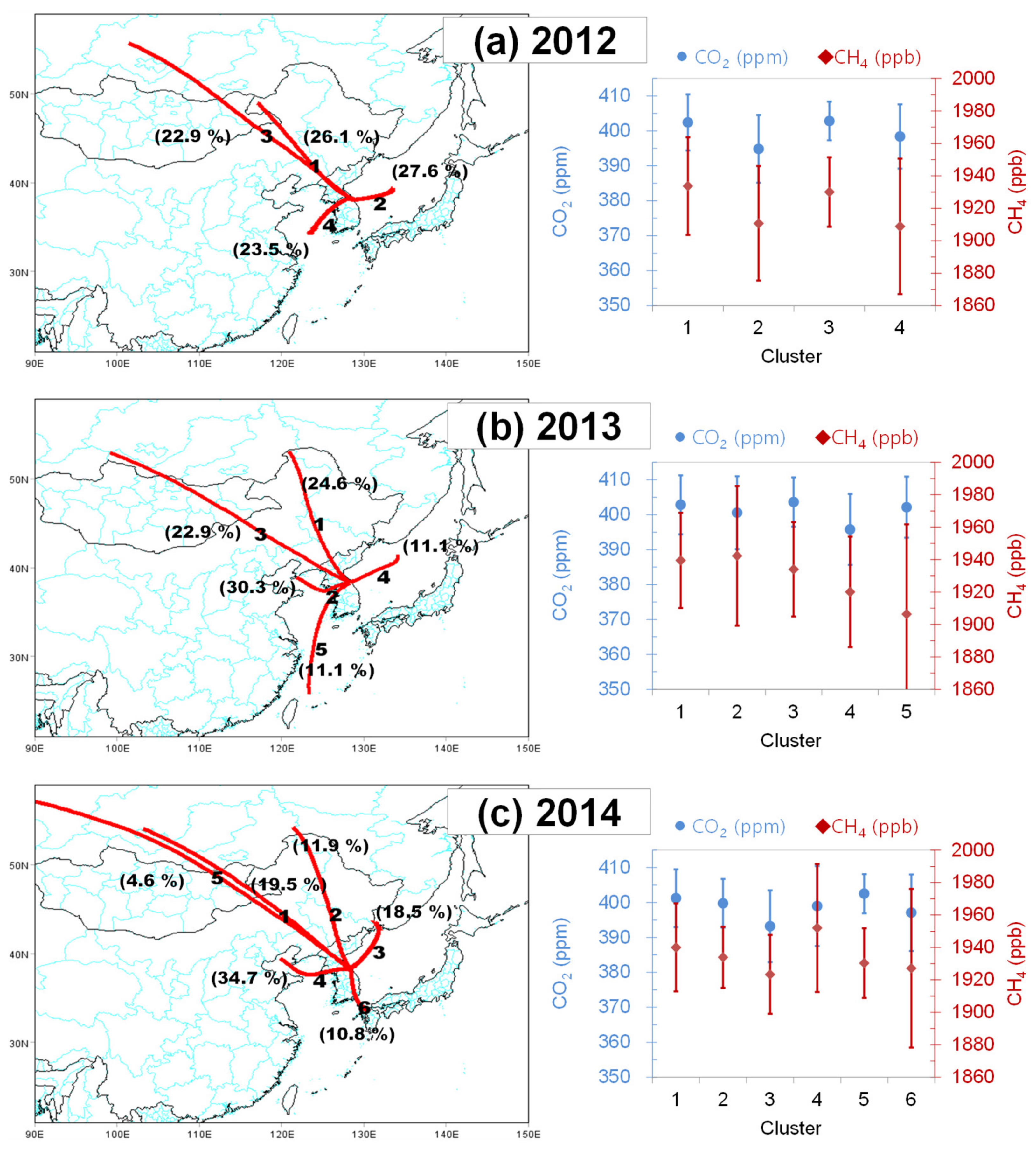

| Year | Polluted Case | Background Case | ||
|---|---|---|---|---|
| CO2 (ppm) | CH4 (ppb) | CO2 (ppm) | CH4 (ppb) | |
| 2012 | 408.3 | 1939 | 395.4 | 1895 |
| 2013 | 410.2 | 1956 | 396.2 | 1900 |
| 2014 | 408.0 | 1963 | 394.5 | 1916 |
| Mean | 408.8 | 1952 | 395.4 | 1904 |


References
- WMO/GAW. The state of greenhouse gases in the atmosphere based on global observations through 2018. In WMO Greenhouse Gas Bulletin; World Meteorological Organization: Geneva, Switzerland, 2019. [Google Scholar]
- WMO/GAW. The state of greenhouse gases in the atmosphere based on global observations through 2013. In WMO Greenhouse Gas Bulletin; World Meteorological Organization: Geneva, Switzerland, 2014. [Google Scholar]
- Canadell, J.G.; Schulze, E.D. Global potential of biospheric carbon management for climate mitigation. Nat. Commun. 2014, 5, 5282. [Google Scholar] [CrossRef] [PubMed]
- Qi, J.; Xin, X.; John, R.; Groisman, P.; Chen, J. Understanding livestock production and sustainability of grassland ecosystems in the Asian Dryland Belt. Ecol. Process. 2017, 6, 22. [Google Scholar] [CrossRef]
- Janssens-Maenhout, G.; Crippa, M.; Guizzardi, D.; Muntean, M.; Schaaf, E.; Dentener, F.; Bergamaschi, P.; Pagliari, V.; Olivier, J.G.J.; Peters, J.A.H.W.; et al. EDGAR v4.3.2 Global Atlas of the three major greenhouse gas emissions for the period 1970–2012. Earth Syst. Sci. Data 2019, 11, 959–1002. [Google Scholar] [CrossRef]
- UNFCCC. Adoption of the Paris Agreement FCCC/CP/2015/L. 9/Rev. 1; United Nations Framework Convention on Climate Change: Paris, France, 2015. [Google Scholar]
- Cheng, I.; Xu, X.; Zhang, L. Overview of receptor-based source apportionment studies for speciated atmospheric mercury. Atmos. Chem. Phys. 2015, 15, 7877–7895. [Google Scholar] [CrossRef]
- Li, S.; Kim, J.; Park, S.; Kim, S.-K.; Park, M.-K.; Mühle, J.; Lee, G.; Lee, M.; Jo, C.O.; Kim, K.-R. Source Identification and Apportionment of Halogenated Compounds Observed at a Remote Site in East Asia. Environ. Sci. Technol. 2014, 48, 491–498. [Google Scholar] [CrossRef]
- Giemsa, E.; Jacobeit, J.; Ries, L.; Hachinger, S. Investigating regional source and sink patterns of Alpine CO2 and CH4 concentrations based on a back trajectory receptor model. Environ. Sci. Eur. 2019, 31, 49. [Google Scholar] [CrossRef]
- Jeong, U.; Kim, J.; Lee, H.; Jung, J.; Kim, Y.J.; Song, C.H.; Koo, J.-H. Estimation of the contributions of long range transported aerosol in East Asia to carbonaceous aerosol and PM concentrations in Seoul, Korea using highly time resolved measurements: A PSCF model approach. J. Environ. Monit. 2011, 13, 1905–1918. [Google Scholar] [CrossRef]
- Cheng, I.; Zhang, L.; Blanchard, P.; Dalziel, J.; Tordon, R. Concentration-weighted trajectory approach to identifying potential sources of speciated atmospheric mercury at an urban coastal site in Nova Scotia, Canada. Atmos. Chem. Phys. 2013, 13, 6031–6048. [Google Scholar] [CrossRef]
- Dimitriou, K.; Kassomenos, P. Three year study of tropospheric ozone with back trajectories at a metropolitan and a medium scale urban area in Greece. Sci. Total Environ. 2015, 502, 493–501. [Google Scholar] [CrossRef]
- Jin, F.; Kim, J.; Kim, K.-R. Estimation of Potential Source Region in Northeast Asia through Continuous In-Situ Measurement of Atmospheric CO2 at Gosan, Jeju Island, Korea. Terr. Atmos. Ocean. Sci. 2010, 21, 313–323. [Google Scholar] [CrossRef][Green Version]
- Seibert, P.; Kromp-Kolb, H.; Baltensperger, U.; Jost, D.; Schwikowski, M.; Kasper, A.; Puxbaum, H. Trajectory Analysis of Aerosol Measurements at High Alpine Sites; Borrell, P.M., Borrell, P., Cvitaš, T., Seiler, W., Eds.; Academic Publishing: Den Haag, The Netherlands, 1994; Volume 15, pp. 689–693. [Google Scholar]
- Polissar, A.V.; Hopke, P.K.; Harris, J.M. Source Regions for Atmospheric Aerosol Measured at Barrow, Alaska. Environ. Sci. Technol. 2001, 35, 4214–4226. [Google Scholar] [CrossRef] [PubMed]
- Hsu, Y.-K.; Holsen, T.M.; Hopke, P.K. Comparison of hybrid receptor models to locate PCB sources in Chicago. Atmos. Environ. 2003, 37, 545–562. [Google Scholar] [CrossRef]
- Carslaw, D.C.; Beevers, S.D.; Ropkins, K.; Bell, M.C. Detecting and quantifying aircraft and other on-airport contributions to ambient nitrogen oxides in the vicinity of a large international airport. Atmos. Environ. 2006, 40, 5424–5434. [Google Scholar] [CrossRef]
- Carslaw, D.C.; Beevers, S.D. Characterising and understanding emission sources using bivariate polar plots and k-means clustering. Environ. Model. Softw. 2013, 40, 325–329. [Google Scholar] [CrossRef]
- Xia, L.; Zhou, L.; Tans, P.P.; Liu, L.; Zhang, G.; Wang, H.; Luan, T. Atmospheric CO2 and its δ13C measurements from flask sampling at Lin’an regional background station in China. Atmos. Environ. 2015, 117, 220–226. [Google Scholar] [CrossRef]
- Schaefer, H.; Fletcher, S.E.M.; Veidt, C.; Lassey, K.R.; Brailsford, G.W.; Bromley, T.M.; Dlugokencky, E.J.; Michel, S.E.; Miller, J.B.; Levin, I.; et al. A 21st-century shift from fossil-fuel to biogenic methane emissions indicated by 13CH4. Science 2016, 352, 80–84. [Google Scholar] [CrossRef] [PubMed]
- MoE. Guidelines for Installation and Operation of Air Pollution Monitoring Network; Ministry of Environment (MoE): Gwacheon, Korea, 2011. (In Korean) [Google Scholar]
- O’Doherty, S.; Simmonds, P.G.; Cunnold, D.M.; Wang, H.J.; Sturrock, G.A.; Fraser, P.J.; Ryall, D.; Derwent, R.G.; Weiss, R.F.; Salameh, P.; et al. In situ chloroform measurements at Advanced Global Atmospheric Gases Experiment atmospheric research stations from 1994 to 1998. J. Geophys. Res. Atmos. 2001, 106, 20429–20444. [Google Scholar] [CrossRef]
- Fang, S.X.; Tans, P.P.; Steinbacher, M.; Zhou, L.X.; Luan, T. Comparison of the regional CO2 mole fraction filtering approaches at a WMO/GAW regional station in China. Atmos. Meas. Tech. 2015, 8, 5301–5313. [Google Scholar] [CrossRef]
- Carslaw, D.C.; Ropkins, K. Openair—An R package for air quality data analysis. Environ. Model. Softw. 2012, 27–28, 52–61. [Google Scholar] [CrossRef]
- Stein, A.F.; Draxler, R.R.; Rolph, G.D.; Stunder, B.J.B.; Cohen, M.D.; Ngan, F. NOAA’s HYSPLIT Atmospheric Transport and Dispersion Modeling System. Bull. Am. Meteorol. Soc. 2015, 96, 2059–2077. [Google Scholar] [CrossRef]
- Makra, L.; Matyasovszky, I.; Guba, Z.; Karatzas, K.; Anttila, P. Monitoring the long-range transport effects on urban PM10 levels using 3D clusters of backward trajectories. Atmos. Environ. 2011, 45, 2630–2641. [Google Scholar] [CrossRef]
- Stohl, A. Computation, accuracy and applications of trajectories—A review and bibliography. Atmos. Environ. 1998, 32, 947–966. [Google Scholar] [CrossRef]
- Reimann, S.; Schaub, D.; Stemmler, K.; Folini, D.; Hill, M.; Hofer, P.; Buchmann, B.; Simmonds, P.G.; Greally, B.R.; O’Doherty, S. Halogenated greenhouse gases at the Swiss High Alpine Site of Jungfraujoch (3580 m asl): Continuous measurements and their use for regional European source allocation. J. Geophys. Res. Atmos. 2004, 109. [Google Scholar] [CrossRef]
- Kong, X.; He, W.; Qin, N.; He, Q.; Yang, B.; Ouyang, H.; Wang, Q.; Xu, F. Comparison of transport pathways and potential sources of PM10 in two cities around a large Chinese lake using the modified trajectory analysis. Atmos. Res. 2013, 122, 284–297. [Google Scholar] [CrossRef]
- Wang, Y.Q.; Zhang, X.Y.; Draxler, R.R. TrajStat: GIS-based software that uses various trajectory statistical analysis methods to identify potential sources from long-term air pollution measurement data. Environ. Model. Softw. 2009, 24, 938–939. [Google Scholar] [CrossRef]
- Oishi, Y.; Ishida, H.; Nakajima, T.Y.; Nakamura, R.; Matsunaga, T. The impact of different support vectors on GOSAT-2 CAI-2 L2 cloud discrimination. Remote Sens. 2017, 9, 1236. [Google Scholar] [CrossRef]
- Park, Y.-J.; Ahn, J.-B. Characteristics of atmospheric circulation over East Asia associated with summer blocking. J. Geophys. Res. Atmos. 2014, 119, 726–738. [Google Scholar] [CrossRef]
- Nemani, R.; White, M.; Thornton, P.; Nishida, K.; Reddy, S.; Jenkins, J.; Running, S. Recent trends in hydrologic balance have enhanced the terrestrial carbon sink in the United States. Geophys. Res. Lett. 2002, 29, 106-1–106-4. [Google Scholar] [CrossRef]
- Shan, Y.; Liu, J.; Liu, Z.; Xu, X.; Shao, S.; Wang, P.; Guan, D. New provincial CO2 emission inventories in China based on apparent energy consumption data and updated emission factors. Appl. Energy 2016, 184, 742–750. [Google Scholar] [CrossRef]
- Sun, J.; Peng, H.; Chen, J.; Wang, X.; Wei, M.; Li, W.; Yang, L.; Zhang, Q.; Wang, W.; Mellouki, A. An estimation of CO2 emission via agricultural crop residue open field burning in China from 1996 to 2013. J. Clean. Prod. 2016, 112, 2625–2631. [Google Scholar] [CrossRef]
- Zhang, B.; Chen, G.Q. China’s CH4 and CO2 emissions: Bottom-up estimation and comparative analysis. Ecol. Indic. 2014, 47, 112–122. [Google Scholar] [CrossRef]
- Zhang, B.; Yang, T.R.; Chen, B.; Sun, X.D. China’s regional CH4 emissions: Characteristics, interregional transfer and mitigation policies. Appl. Energy 2016, 184, 1184–1195. [Google Scholar] [CrossRef]
- WMO/GAW. The state of greenhouse gases in the atmosphere based on global observations through 2012. In WMO Greenhouse Gas Bulletin; World Meteorological Organization: Geneva, Switzerland, 2013. [Google Scholar]
- WMO/GAW. The state of greenhouse gases in the atmosphere based on global observations through 2014. In WMO Greenhouse Gas Bulletin; World Meteorological Organization: Geneva, Switzerland, 2015. [Google Scholar]
- GIR. 2016 National Greenhouse Gas Inventory Report of Korea; Greenhouse Gas Inventory & Research Center (GIR): Seoul, Korea, 2016. (In Korean) [Google Scholar]
- MOTIE/KEEI. Yearbook of Energy Statistics; Ministry of Trade, Industry and Energy (MOTIE) and Korea Energy Economics Institute (KEEI) (MOTIE/KEEI): Ulsan, Korea, 2015. (In Korean) [Google Scholar]
- NIER. Handbook of Greenhouse Gases-Clean Air Policy Support System (GHG-CAPSS) Emissions Inventory; National Institute of Environmental Research (NIER): Incheon, Korea, 2016. (In Korean) [Google Scholar]
- Jacob, D.J. Introduction to Atmospheric Chemistry; Princeton University Press: Princeton, NJ, USA, 1999. [Google Scholar]
- Chan, J.C.L.; Li, C. The East Asia Winter Monsoon. In East Asian Monsoon; Chang, C.-P., Ed.; World Scientific: Hackensack, NJ, USA, 2004; pp. 54–106. [Google Scholar] [CrossRef]
- Park, T.-W.; Ho, C.-H.; Jeong, J.-H.; Heo, J.-W.; Deng, Y. A new dynamical index for classification of cold surge types over East Asia. Clim. Dyn. 2015, 45, 2469–2484. [Google Scholar] [CrossRef]
- Kemp, J.F.; Young, P. Notes on Meteorology, 3rd ed.; Routledge: London, UK; New York, NY, USA, 1993. [Google Scholar]
- Ha, K.-J.; Park, S.-K.; Kim, K.-Y. On interannual characteristics of Climate Prediction Center merged analysis precipitation over the Korean peninsula during the summer monsoon season. Int. J. Climatol. 2005, 25, 99–116. [Google Scholar] [CrossRef]
- Chen, D.; Wang, X.; Li, Y.; Lang, J.; Zhou, Y.; Guo, X.; Zhao, Y. High-spatiotemporal-resolution ship emission inventory of China based on AIS data in 2014. Sci. Total Environ. 2017, 609, 776–787. [Google Scholar] [CrossRef] [PubMed]
- Liu, H.; Fu, M.; Jin, X.; Shang, Y.; Shindell, D.; Faluvegi, G.; Shindell, C.; He, K. Health and climate impacts of ocean-going vessels in East Asia. Nat. Clim. Chang. 2016, 6, 1037–1041. [Google Scholar] [CrossRef]
- Fu, M.; Liu, H.; Jin, X.; He, K. National- to port-level inventories of shipping emissions in China. Environ. Res. Lett. 2017, 12, 114024. [Google Scholar] [CrossRef]
- Chen, D.; Zhao, Y.; Nelson, P.; Li, Y.; Wang, X.; Zhou, Y.; Lang, J.; Guo, X. Estimating ship emissions based on AIS data for port of Tianjin, China. Atmos. Environ. 2016, 145, 10–18. [Google Scholar] [CrossRef]
- Wang, C.; Corbett, J.J.; Firestone, J. Improving Spatial Representation of Global Ship Emissions Inventories. Environ. Sci. Technol. 2008, 42, 193–199. [Google Scholar] [CrossRef]
- Hong, D.-B.; Yang, C.-S.; Kim, T.-H. Investigation of Passing Ships in Inaccessible Areas Using Satellite-based Automatic Identification System (S-AIS) Data. Korean J. Remote Sens. 2018, 34, 579–590. [Google Scholar]
- Jin, F.; Fang, Y.; Chen, T.; Li, D.; Kim, J.; Park, M.-K.; Park, S.; Kim, K.-R. In situ measurement of atmospheric carbon dioxide at Yanbian, China: Estimating its northeast Asian emission regions. Sci. China Earth Sci. 2012, 55, 1742–1754. [Google Scholar] [CrossRef]
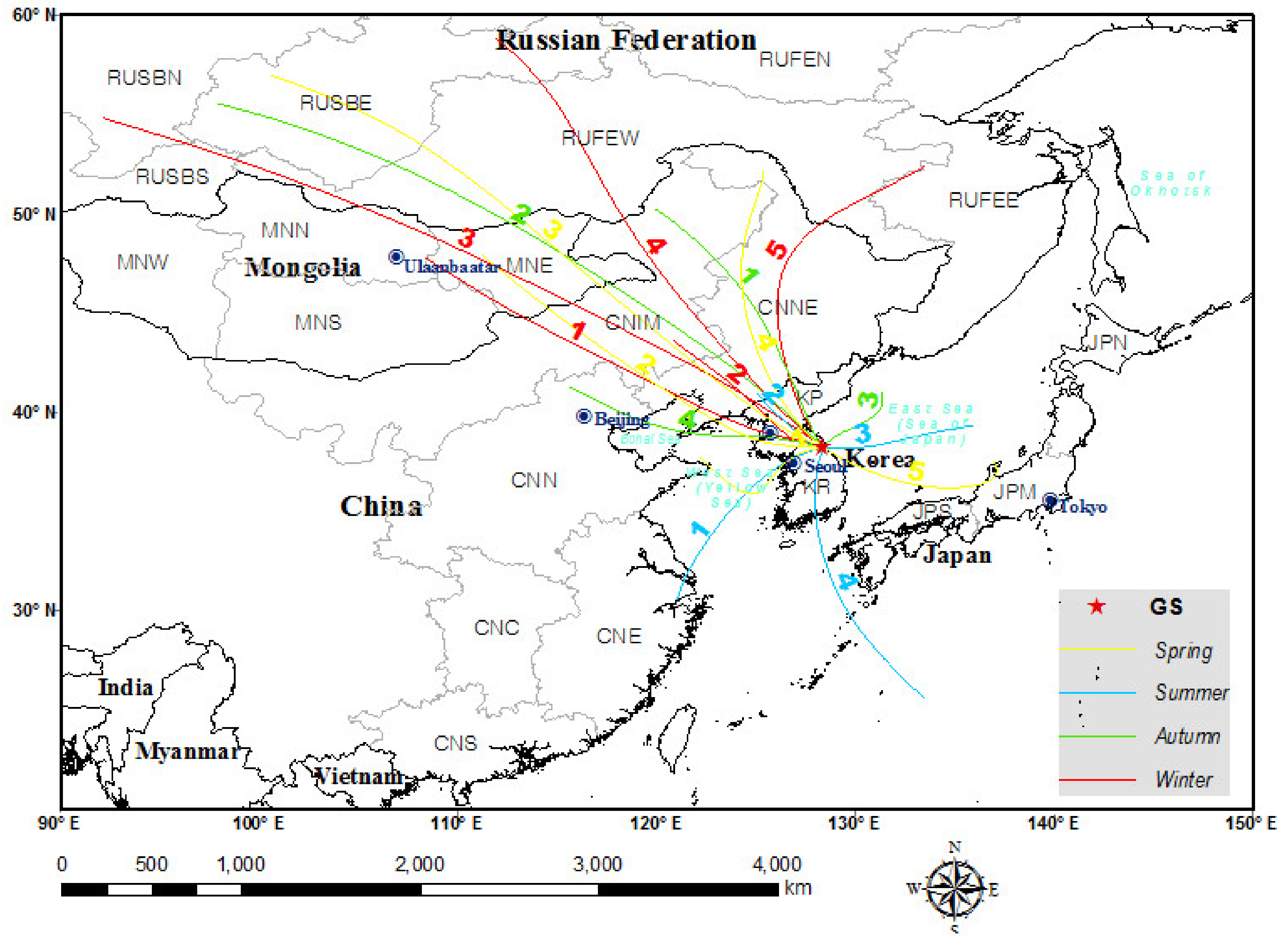
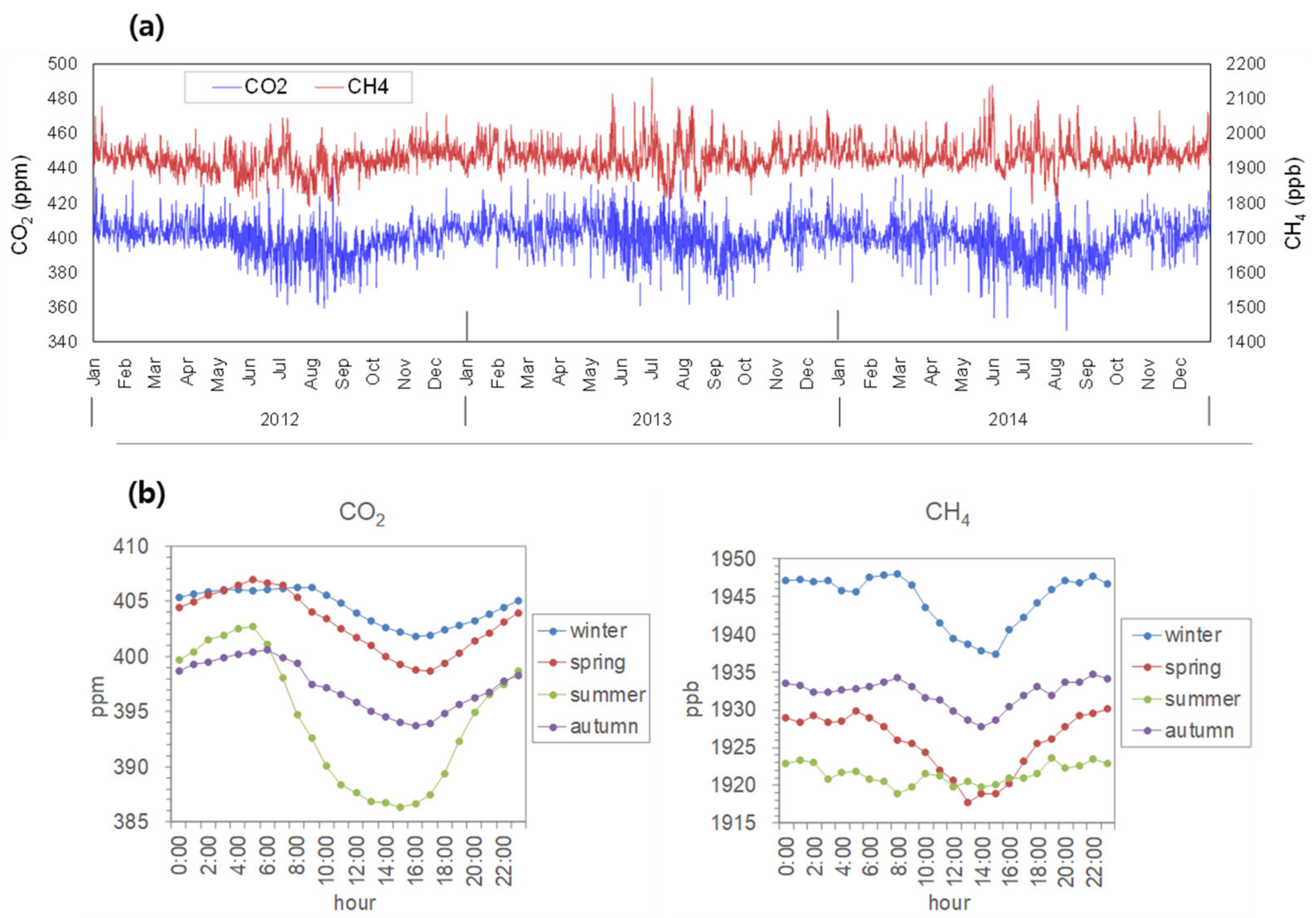
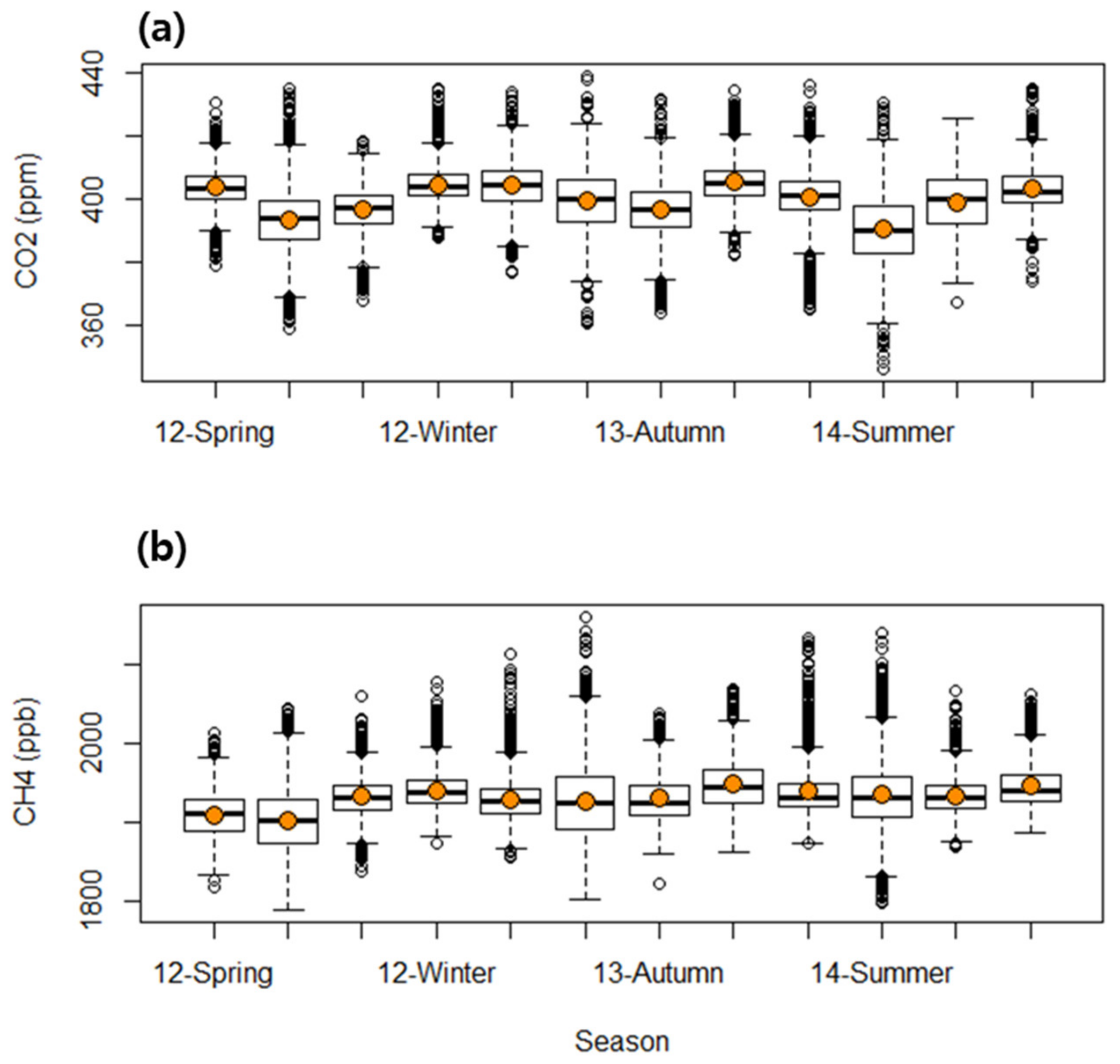
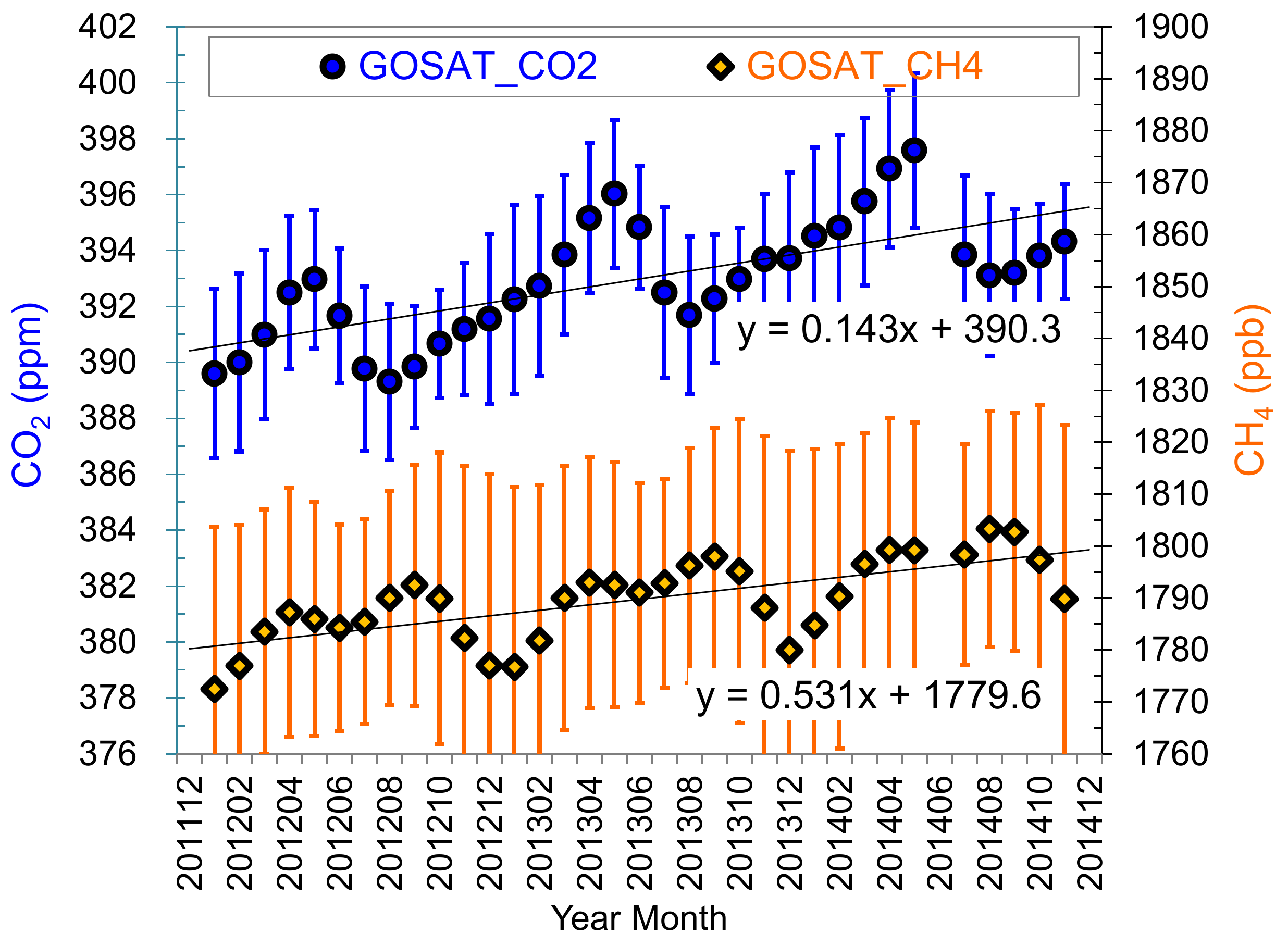


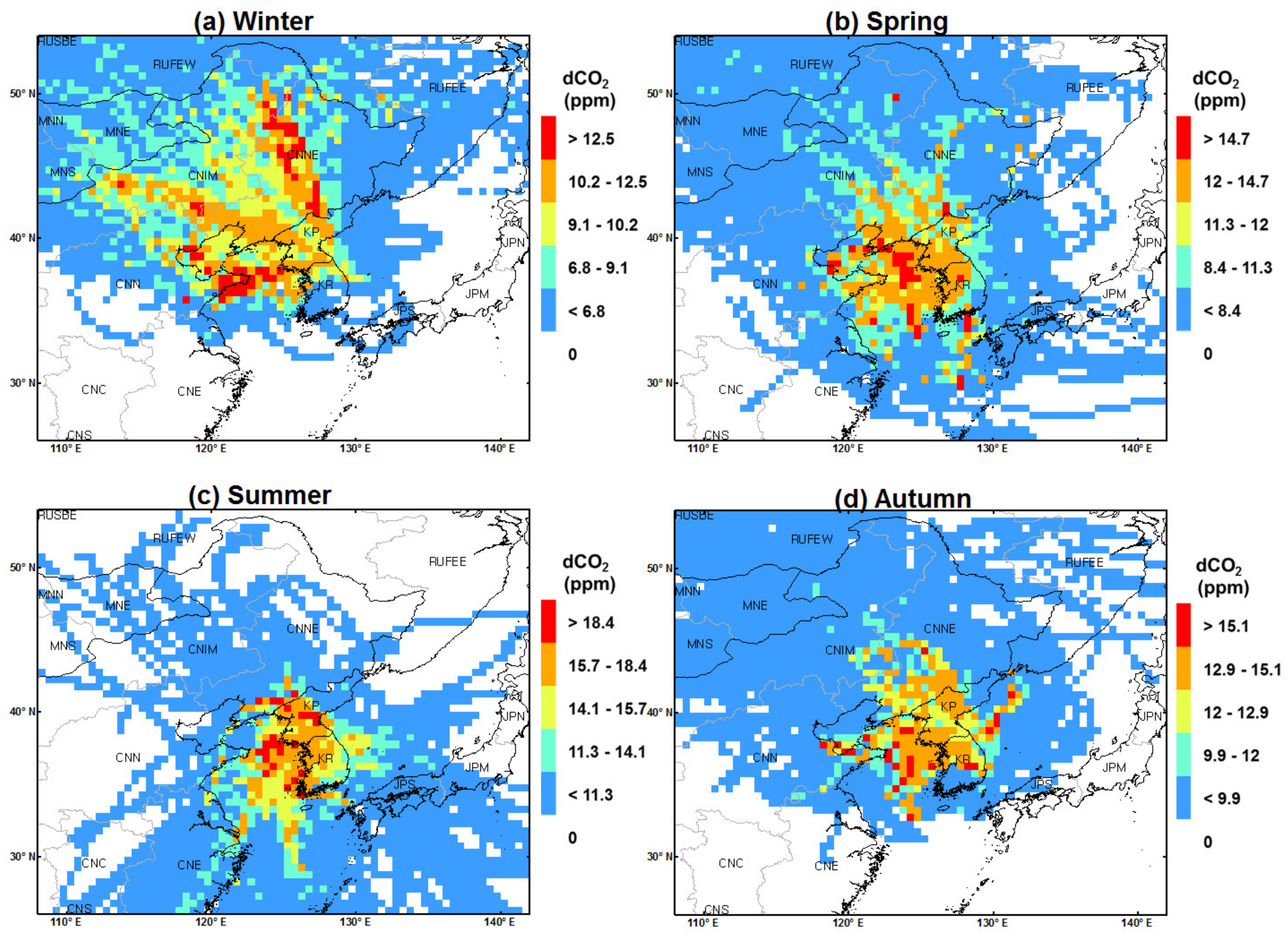
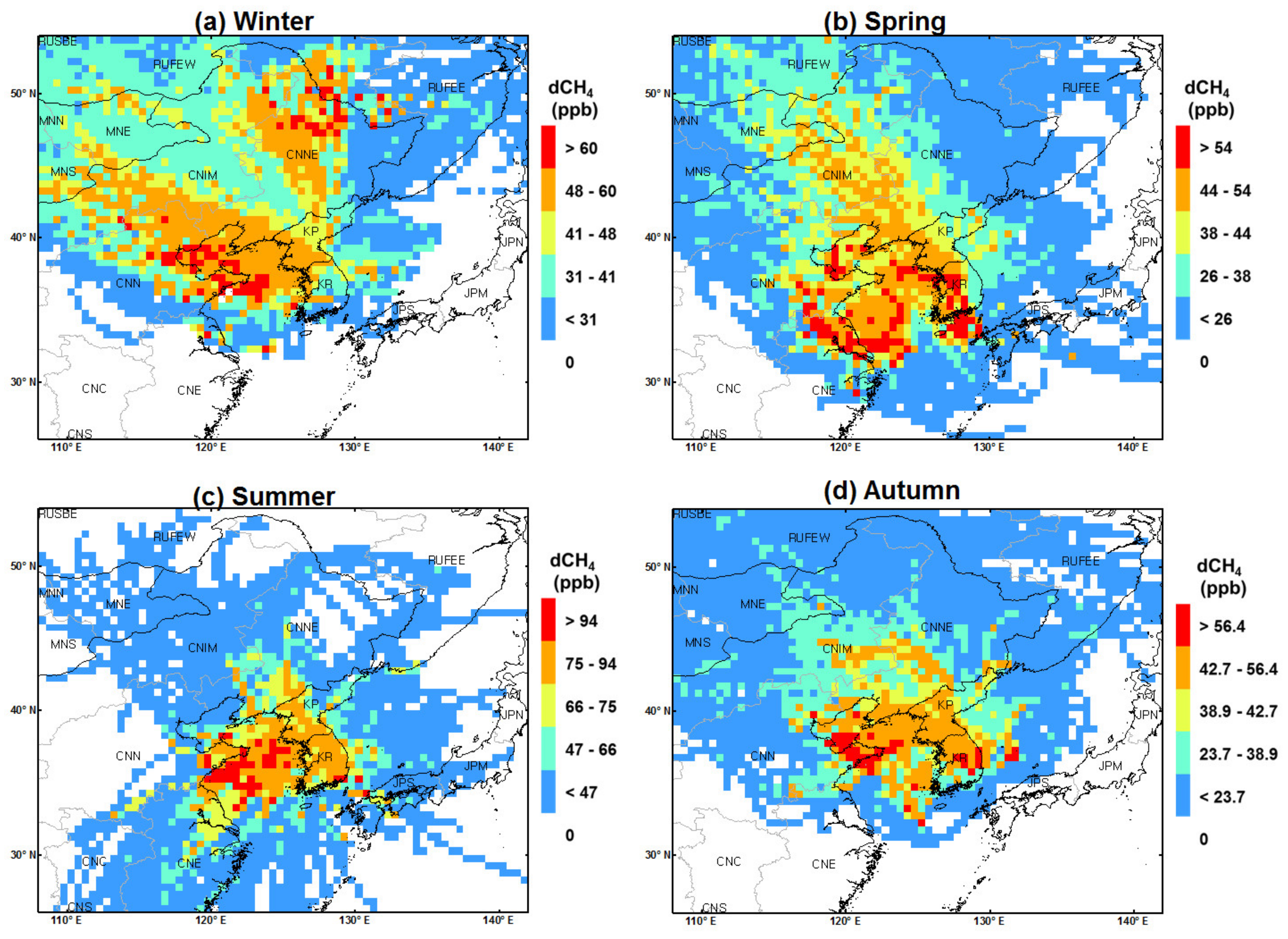
| Year | GS (This Study) | Global Average * | ||
|---|---|---|---|---|
| CO2 (ppm) | CH4 (ppb) | CO2 (ppm) | CH4 (ppb) | |
| 2012 | 399.6 | 1920.7 | 393.1 | 1818 |
| 2013 | 401.5 | 1933.4 | 395.8 | 1824 |
| 2014 | 398.4 | 1938.7 | 397.7 | 1833 |
| Mean | 399.8 | 1930.9 | 395.5 | 1825 |
| Season | Cluster | Fraction (%) | CO2bg (ppm) | CH4bg (ppb) | dCO2 (ppm) | dCH4 (ppb) |
|---|---|---|---|---|---|---|
| Winter | 1 | 21.4 | 399.4 ± 3.8 | 1914 ± 10 | 11.3 ± 5.9 | 55 ± 30 |
| 2 | 22.1 | 400.1 ± 3.5 | 1913 ± 11 | 10.7 ± 4.9 | 52 ± 26 | |
| 3 | 22.6 | 400.1 ± 3.7 | 1911 ± 14 | 9.5 ± 4.4 | 42 ± 22 | |
| 4 | 24.3 | 400.7 ± 3.3 | 1913 ± 13 | 8.5 ± 3.6 | 40 ± 21 | |
| 5 | 9.6 | 400.1 ± 4.0 | 1918 ± 8 | 12.0 ± 6.1 | 63 ± 33 | |
| Spring | 1 | 38.3 | 398.3 ± 6.5 | 1900 ± 20 | 13.4 ± 5.1 | 47 ± 31 |
| 2 | 17.4 | 398.0 ± 6.7 | 1906 ± 20 | 10.9 ± 5.5 | 50 ± 30 | |
| 3 | 18.1 | 400.5 ± 4.3 | 1909 ± 18 | 10.4 ± 4.1 | 43 ± 19 | |
| 4 | 18.9 | 400.4 ± 4.7 | 1909 ± 22 | 12.1 ± 5.7 | 34 ± 15 | |
| 5 | 7.4 | 399.5 ± 3.7 | 1889 ± 24 | 12.0 ± 3.7 | 32 ± 22 | |
| Summer | 1 | 28.8 | 391.7 ± 8.2 | 1891 ± 30 | 16.5 ± 6.4 | 83 ± 40 |
| 2 | 35.3 | 389.5 ± 8.8 | 1909 ± 25 | 16.0 ± 6.3 | 71 ± 31 | |
| 3 | 21 | 388.0 ± 8.8 | 1904 ± 24 | 11.9 ± 4.1 | 59 ± 27 | |
| 4 | 14.9 | 391.9 ± 7.4 | 1859 ± 34 | 15.4 ± 5.2 | 77 ± 61 | |
| Autumn | 1 | 23.9 | 394.5 ± 6.4 | 1917 ± 13 | 13.1 ± 3.7 | 38 ± 19 |
| 2 | 19.7 | 396.9 ± 5.3 | 1915 ± 12 | 11.7 ± 4.0 | 33 ± 19 | |
| 3 | 31.9 | 391.1 ± 7.6 | 1912 ± 19 | 13.5 ± 5.3 | 48 ± 21 | |
| 4 | 24.5 | 394.5 ± 6.8 | 1923 ± 15 | 13.2 ± 4.6 | 48 ± 26 |
| Season | CO2 | Reference | |
|---|---|---|---|
| Major Source Area | Major Sector | ||
| Winter | CNIM: the mid and east of CNIM | raw coal combustion for energy generation | [34] |
| CNNE: the west of Heilongjiang, the mideast of Liaoning and the midnorth-to-south of Jilin | coal washing, crude oils and petroleum refineries, heavy industries | [34] | |
| CNN: the central and on-/off-shore areas of eastern Shandong | coal combustion, oil refining, coal washing and industrial activities | [34] | |
| KP: Yanggang and Pyeongan | manufacturing industries, fuel combustion for power generation, and residential and other sectors | [5] | |
| KR: northwest, west, central areas of Incheon | fuel combustion for public electricity/heat, transportation and industries | [42] | |
| Spring | CNIM: the east of CNIM | raw coal combustion for energy generation | [34] |
| CNNE: the southwest of Jilin, and the midnorth-to-south and the east of Liaoning | heavy industry and petroleum refineries | [34] | |
| CNN: the on-/off-shore areas of the northern Shandong | coal washing, heavy industries, and petroleum refineries | [34] | |
| KR: border area of Gangwon, Gyeonggi and Chungcheong | fuel combustion for nonmetal industries and transportation | [42] | |
| Summer | CNNE: the south of Liaoning | petroleum refineries | [34] |
| KP: north area of Pyeongan and south areas of Hamgyong | manufacturing industries, fuel combustion for power generation, and residential and other sectors | [5] | |
| Autumn | CNNE: mid-north of Jilin | heavy industry | [34] |
| CNN: the north and north coasts of Shandong and the east coasts of Shandong | coal washing, heavy industries, and petroleum refineries | [34] | |
| KR: west area of the northern Gyeongsang | fuel combustion for nonmetal/metal industries, transportation | [42] | |
| Season | CH4 | Reference | |
|---|---|---|---|
| Major Source Area | Major Sector | ||
| Winter | RUFEW and RUFEE: the southeast of Amurskaya and the south of Khabarovsk | coal mining, fugitive emissions from oil and gas | [5] |
| CNNE: the midnorth of Heilongjiang | coal mining and enteric fermentation | [36] | |
| CNN: some areas in northern and mid Hebei, the south of Tianjin, the mid and east parts and the east coasts of Shandong | coal mining, enteric fermentation, and MSW landfill, fugitive emissions from shipping and aviation activities | [36] | |
| CNE: the mid Jiangsu | rice cultivation and MSW landfill | [36] | |
| Spring | CNN: the north of Shandong | enteric fermentation and waste management sectors (MSW land fill and the wastewater treatment) | [36] |
| CNE: the west of Jiangsu, Shanghai and the border area of the southern Jiangsu and Shanghai | rice cultivation and MSW landfill | [36] | |
| KP: Pyeongan, Pyongyang, and Hwanghae | coal mining, rice cultivation, wastewater treatment, solid waste disposal | [5] | |
| KR: some city areas of Gyeonggi, northwest and central areas of Incheon, northwest and southwest areas of Gangwon, west areas of Chungcheong, central and west areas of the northern Jeolla, west areas of the southern Jeolla, some south and north areas of Gyeongsang, some areas in Jeju | rice cultivation, enteric fermentation, fugitive emissions from energy sector, solid waste disposal | [42] | |
| JP: Nagasaki in western JPS | rice cultivation, the enteric fermentation, and the wastewater treatment | [5] | |
| Summer | CNN: the mid and eastern Shandong and the north and southeast coasts of Shandong | enteric fermentation, MSW land fill and industrial wastewater treatment | [36] |
| KR: southeast areas in Gyeongsang | enteric fermentation, rice cultivation, energy sectors, manure management | [42] | |
| JP: Nagasaki in western JPS | rice cultivation, the enteric fermentation, and the wastewater treatment | [5] | |
| Autumn | CNN: border area of mid Hebei and Tianjin, the north and east parts and the north and east coasts of Shandong | enteric fermentation, MSW land fill and industrial wastewater treatment | [36] |
| KR: east areas of the southern Gangwon, west, central and eastern areas of the northern Geyongsang | solid waste disposal, enteric fermentation and rice cultivation | [42] | |
© 2020 by the authors. Licensee MDPI, Basel, Switzerland. This article is an open access article distributed under the terms and conditions of the Creative Commons Attribution (CC BY) license (http://creativecommons.org/licenses/by/4.0/).
Share and Cite
Kim, H.-K.; Song, C.-K.; Hong, S.-C.; Shin, M.-H.; Seo, J.; Kim, S.-K.; Lyu, Y. Source Characteristics of Atmospheric CO2 and CH4 in a Northeastern Highland Area of South Korea. Atmosphere 2020, 11, 509. https://doi.org/10.3390/atmos11050509
Kim H-K, Song C-K, Hong S-C, Shin M-H, Seo J, Kim S-K, Lyu Y. Source Characteristics of Atmospheric CO2 and CH4 in a Northeastern Highland Area of South Korea. Atmosphere. 2020; 11(5):509. https://doi.org/10.3390/atmos11050509
Chicago/Turabian StyleKim, Hyeon-Kook, Chang-Keun Song, Sung-Chul Hong, Myung-Hwan Shin, Jeonghyeon Seo, Sang-Kyun Kim, and Youngsook Lyu. 2020. "Source Characteristics of Atmospheric CO2 and CH4 in a Northeastern Highland Area of South Korea" Atmosphere 11, no. 5: 509. https://doi.org/10.3390/atmos11050509
APA StyleKim, H.-K., Song, C.-K., Hong, S.-C., Shin, M.-H., Seo, J., Kim, S.-K., & Lyu, Y. (2020). Source Characteristics of Atmospheric CO2 and CH4 in a Northeastern Highland Area of South Korea. Atmosphere, 11(5), 509. https://doi.org/10.3390/atmos11050509






